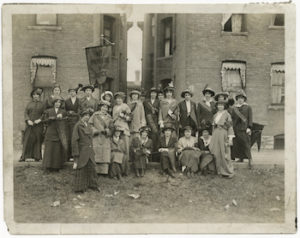
MWSA
*The Minnesota Woman Suffrage Association (MWSA) was founded on this date in 1881. MWSA was an organization devoted to women's suffrage in Minnesota.
After the American Civil War and the fall of Reconstruction, activism from Blacks and women found common ground against voter suppression. Created at the Presbyterian Church in Hastings, Minnesota, the MWSA members organized marches, wrote petitions and letters, gathered signatures, gave speeches, and published pamphlets and broadsheets to force the Minnesota Legislature to recognize their right to vote.
A letter to the editor of the Hastings Gazette: on Saturday, September 17, 1881, read: "It is earnestly desired that the state convention of the Woman's Christian Temperance Union, to be held in this city next week, will be considered an important and significant event. The temperance question is taking a deep hold of the scientific thought and religious heart of the time. It is no longer regarded as merely moral or as an exclusively religious or charitable question, but as one entering deeply into the curious problems of physiology, touching economic and political issues, and infoldings the very social and family life of the people. May there be a general interest in this question manifested by a large attendance of our citizens at this convention of temperance workers. MAD." The editor did not consider it a significant event because on September 24, under the heading: "Minor Topics." "The annual convention of the Woman's Christian Temperance Union (WCTU) was held in the Presbyterian Church this week with a fair attendance, but a report of the same is unavoidably crowded out by other matters." What was not reported was that 14 of the women in attendance formed The Minnesota Woman Suffrage Association at the meeting on September 20, 1881.
Susan B. Anthony, Elizabeth Cady Stanton, and Matilda Joslyn Gage documented the meeting in their publication: History of Woman Suffrage; Volume 3. 1876 - 1885. They recorded the names of the 14 charter members. Three of the MWSA charter member were from Hastings Maria Van Hoesen, Keziah Webster, and Minnie Reed. Maria Van Hoesen and Minnie Reed are buried in Lakeside Cemetery in Hastings, Minnesota.
The History:
In the 1870s, many women across Minnesota organized local women's suffrage groups. In 1875, the Minnesota legislature recognized women's right to vote in school board elections. However, many women wanted to vote in all elections. Seeing the need for a statewide agency, fourteen women formed the MWSA in Hastings in 1881. The Minnesota chapter is affiliated with the National American Woman Suffrage Association (NAWSA). Among the founders of the MWSA were Harriet Bishop and Sarah Burger Stearns. Stearns became the organization's first president. By 1882, the MWSA had grown to two hundred members. In 1885, MWSA-president Martha Ripley convinced NAWSA to hold their annual meeting in Minnesota. This national event demonstrated the importance of the Minnesota chapter to the larger organization. It also drew the attention of Minnesota's male lawmakers.
In 1893, the MWSA convinced the Minnesota Senate to take up women's suffrage. President Julia Bullard Nelson worked with Ignatius Donnelly, a Populist state senator. The Populists regularly supported a women's suffrage plank. Nelson herself was a Populist school superintendent candidate in 1894. Nelson and Donnelly initially sought the vote for women in municipal elections. However, the Senate went further. Its members voted to remove the word "male" from the state's voting requirements. The bill passed from thirty-two to nineteen. However, this change did not pass the House. After the failure of the 1893 amendment, the movement continued. However, the MWSA was unable to build on its earlier success. The MWSA and its ally, the Political Equality Club, placed women's suffrage before the state legislature every session. Each time, the bill either died in committee or was defeated.
In the early 20th century:
During the 1910s, the movement picked up momentum again. In 1914, Clara Ueland - who would later become the MWSA's president in 1915 - organized a parade through Minneapolis of over 2000 suffrage supporters. This event gave the movement renewed attention. During this period, the MWSA had to contend with a rival organization, a Minnesota National Woman's Party (NWP) branch. The NWP was more radical than the MWSA. It was much more likely to take direct action, such as hunger strikes than the MWSA. By 1919, 30,000 women across the state officially belonged to local suffrage associations. They joined the MWSA, the NWP, and other organizations. Their numbers and ongoing activities convinced lawmakers to act. In 1919, the Minnesota legislature recognized women's right to vote in presidential elections. The same year, the legislature ratified the Nineteenth Amendment. However, the amendment did not take effect until 1920, two-thirds of the required states approved it.
Present Day:
With their right to vote secured, the MWSA became the Minnesota League of Women Voters, selecting Clara Ueland as their first president. Today, the League is still active in Minnesota politics, publishing a voting guide to inform voters on candidate positions on issues affecting women. A memorial to the achievements of the MWSA currently stands on the lawn of the Minnesota State Capitol and is known as the Minnesota Woman Suffrage Memorial.
